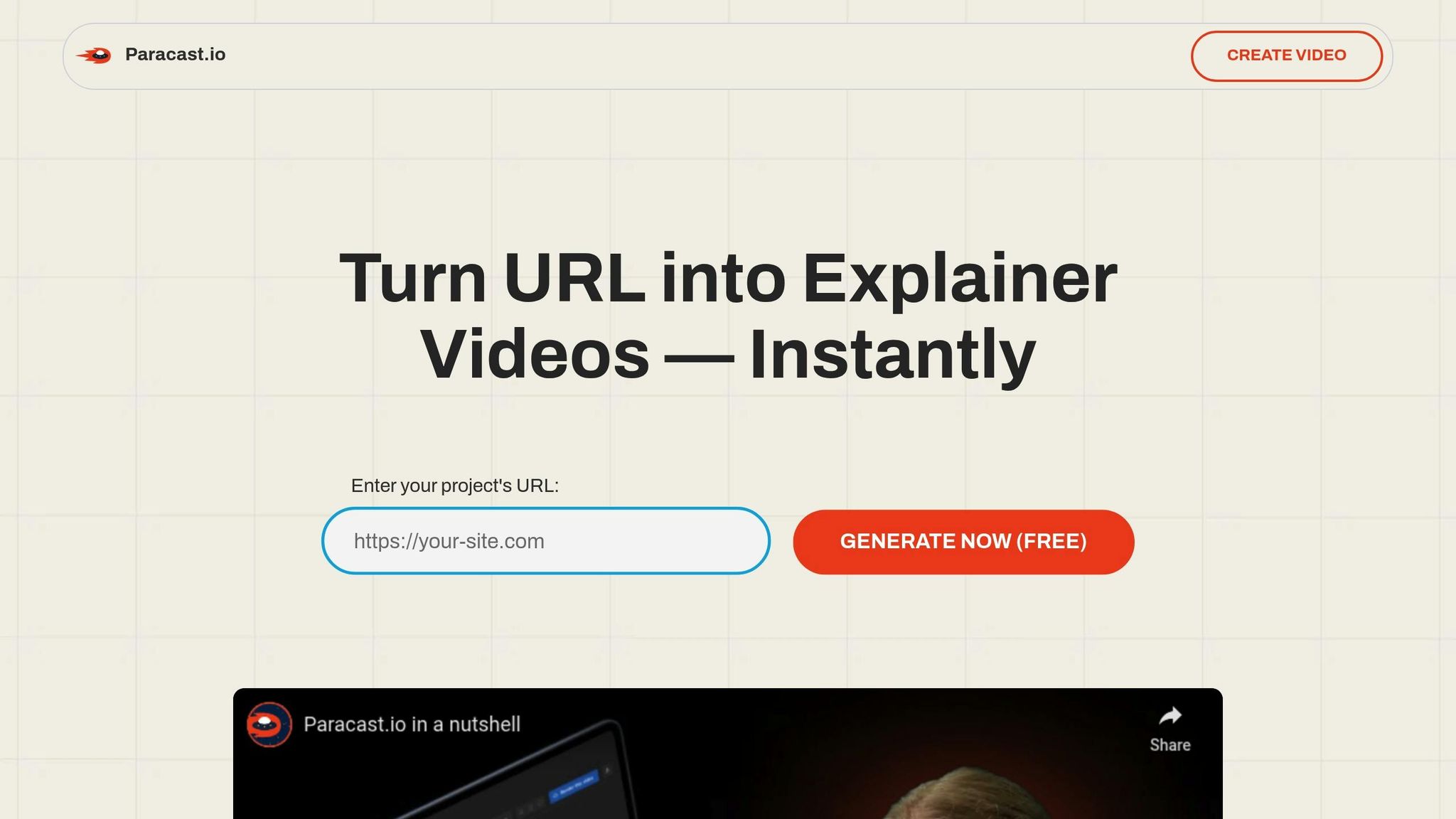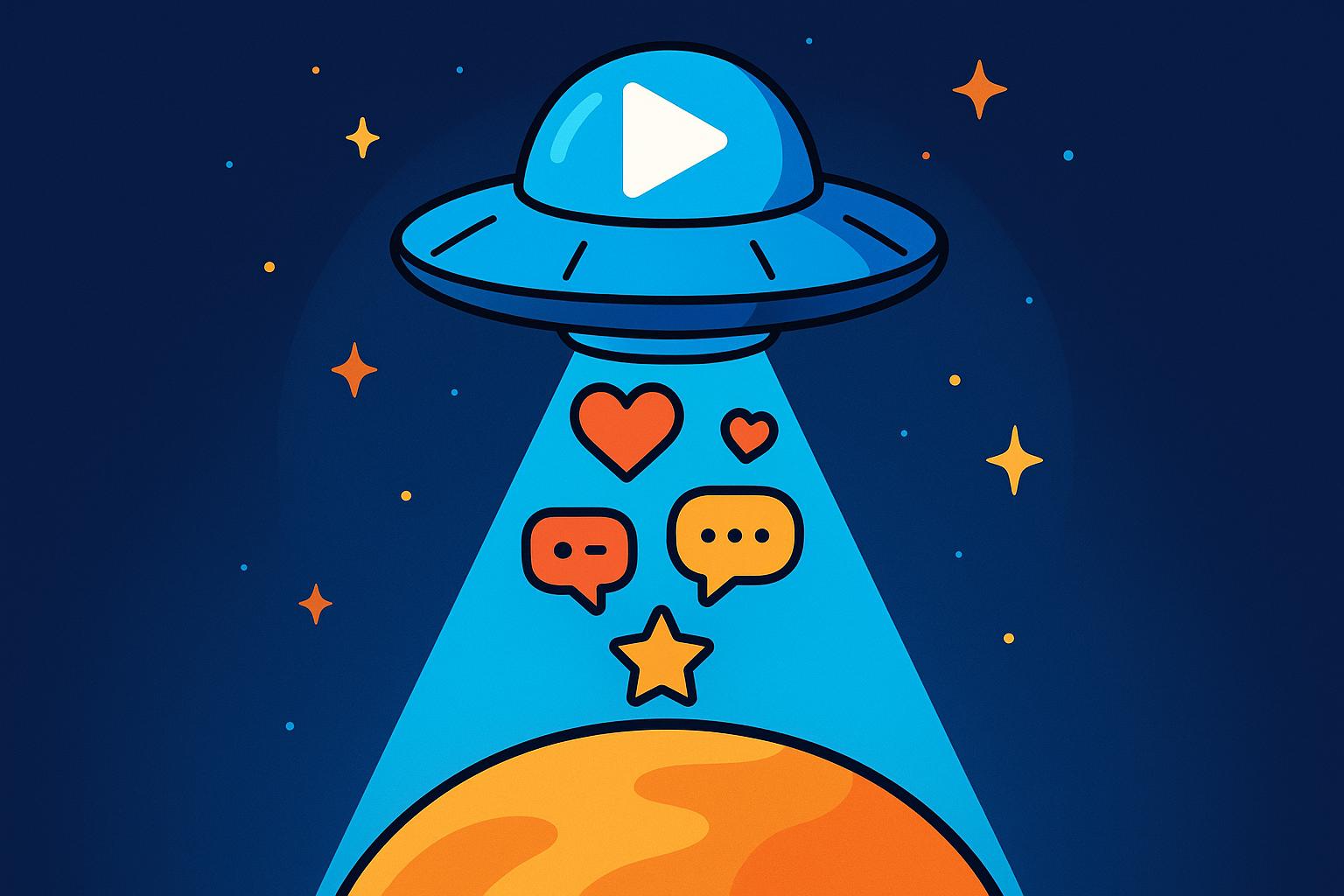AI videos for brand awareness can deliver strong ROI, but measuring their impact requires a different approach than direct-sales campaigns. Here’s how you can evaluate their success:
- Key Metrics: Focus on reach, impressions, engagement rates, website traffic, social media growth, branded search volume, and video completion rates.
- Challenges: Assigning value to intangible outcomes like brand recognition or follower growth and tracking long-term effects.
- ROI Formula: (Value of Outcomes - Campaign Costs) / Campaign Costs × 100. Assign monetary value to metrics like increased search traffic, website visits, and social growth.
- Tools: Platforms like Paracast.io simplify video creation and analytics, reducing costs and improving tracking.
- Optimization: Use data to refine strategies, test video variations, and adjust based on performance trends.
Measuring ROI of AI-Driven Campaigns | Exclusive Lesson
Key Metrics for Measuring Brand Awareness Impact
Measuring the success of your AI video campaign starts with identifying the right metrics. By focusing on both quantitative and qualitative indicators, you can get a clearer picture of how your brand is gaining traction in the market. Let’s dive into the core metrics that matter.
Core Metrics for AI Video Campaigns
Reach and impressions form the backbone of brand awareness measurement. Reach tells you how many unique individuals viewed your AI video, while impressions count the total number of times the video appeared on screens. When building brand awareness, reach often takes priority over impressions because the goal is to introduce your brand to new audiences. For instance, a video with 50,000 reach and 75,000 impressions suggests strong organic sharing.
Engagement rate is a key indicator of how well your video resonates with viewers. This metric includes likes, comments, shares, saves, and click-throughs relative to impressions. On most social platforms, a solid engagement rate for brand awareness videos typically falls between 2% and 5%, though this can vary depending on your industry and audience size. High engagement means your message is striking a chord, making it more likely viewers will remember your brand.
Website traffic from video sources shows whether your AI videos are driving interest. Use tools like Google Analytics to track increases in direct, referral, and branded search traffic after your videos go live. This data can help you understand how effectively your videos are converting views into website visits.
Share of voice measures how often your brand is mentioned compared to competitors in your industry. This includes mentions on social media, blogs, forums, and news articles. A growing share of voice suggests your brand is gaining attention. Social listening tools can help you monitor these mentions and analyze the sentiment behind them.
Branded search volume reflects how many people are actively searching for your company after seeing your videos. Tools like Google Search Console or keyword research platforms can help you track searches for your brand name, product names, or other branded terms. A 20% to 30% increase in branded search volume within a month of launching your video campaign is a strong indicator of success.
Video completion rates reveal how engaging your content is. For brand awareness campaigns, aim for at least 50% completion rates on videos under 60 seconds and 25% to 35% for longer videos. High completion rates suggest viewers are staying engaged long enough to absorb your message.
Social media follower growth is a straightforward way to measure increased interest in your brand. Keep an eye on new followers across platforms, paying attention to how well they align with your target audience and how engaged they are.
Pros and Cons of Brand Awareness Metrics
Each of these metrics offers unique insights, but they also have limitations. To get a well-rounded understanding of your campaign’s performance, it’s important to recognize both the strengths and weaknesses of these indicators.
| Metric | Strengths | Weaknesses |
|---|---|---|
| Reach & Impressions | Easy to track, shows campaign scale, helpful for comparing videos | Doesn’t reflect quality of exposure, may include accidental views, can be vanity metrics |
| Engagement Rate | Shows content quality, indicates audience interest, links to memorability | Varies by platform, can be artificially inflated, doesn’t guarantee brand recall |
| Website Traffic | Provides behavioral data, shows intent, easy to calculate ROI | May not capture all awareness impact, influenced by other marketing efforts |
| Share of Voice | Offers competitive context, tracks market position, captures organic mentions | Costly to track comprehensively, may include negative mentions, reporting delays |
| Branded Search Volume | Highlights intent, directly linked to campaigns, free to monitor | Limited to search behavior, doesn’t capture all awareness, affected by seasonal trends |
| Video Completion Rates | Reflects content effectiveness, shows message delivery, platform-specific insights | Doesn’t measure retention, varies by video length, subject to platform algorithms |
The best approach combines leading indicators like engagement and completion rates with lagging indicators such as branded search volume and share of voice. Leading indicators help you fine-tune your campaigns in real time, while lagging indicators show the long-term impact of your efforts.
Refining Analysis with Cost Metrics
To dig deeper, calculate efficiency metrics like cost per thousand impressions, cost per engagement, and cost per website visitor. These metrics allow you to compare the performance of different videos and allocate your budget more effectively. For example, a video that generates website visits at $2.50 each might outperform one costing $1.00 per visit if the first group shows higher purchase intent or spends more time on your site.
Tracking these metrics consistently over time is crucial. Start by establishing baseline data before launching your AI video campaigns. Then, monitor changes weekly and monthly to spot trends and adjust your strategy based on how your audience responds to different types of content.
Step-by-Step Guide to Calculating AI Video ROI
Measuring ROI for brand awareness campaigns requires a slightly different approach compared to direct-response efforts. While you might not see an immediate link between video views and sales, you can still assign monetary value to awareness-driven results and calculate your return on investment (ROI). Here’s a breakdown of how to do it step by step.
ROI Calculation Formula
The formula for calculating ROI in brand awareness campaigns is straightforward:
ROI = (Value of Awareness Outcomes - Campaign Investment) / Campaign Investment × 100
The "value" here includes both direct and indirect benefits, which might take weeks or even months to fully materialize. Unlike campaigns focused on immediate conversions, awareness efforts often build momentum over time, so tracking results over an extended period is crucial.
For AI video campaigns, your total investment typically includes production costs (e.g., a Paracast.io subscription) and distribution expenses. For example, a small business might spend anywhere from $2,000 to $5,000 per month on such campaigns.
The real challenge lies in assigning clear dollar values to outcomes that might feel intangible at first glance.
Assigning Value to Awareness Outcomes
To quantify awareness-driven results, you’ll need to translate them into monetary terms. Here are some effective methods:
- Customer Lifetime Value (CLV) Attribution: Estimate what portion of new customers discovered your brand through video content. For instance, if your average CLV is $1,200 and 15% of new customers can be linked to your video campaigns, you can assign a proportional value to those efforts. Pre-planning this attribution process is key.
- Branded Search Value: Use tools like Google Ads Keyword Planner to calculate the value of increased search volume for your brand. For example, if branded searches rise by 2,500 per month and the average cost-per-click (CPC) for those terms is $3.20, that equates to $8,000 in advertising value.
- Website Traffic Valuation: Translate increased site visits into revenue. If your site sees 1,000 additional visitors per month, with a 2.5% conversion rate and an average order value of $150, that’s $3,750 in projected revenue.
- Social Media Growth: Assign a value to new followers and engagement. Research suggests that engaged followers are worth $1.78 to $8.50 each, depending on the industry. For awareness campaigns, use the lower end of this range to account for delayed conversions.
- Share of Voice: Compare your growth in organic mentions to the cost of achieving similar exposure through paid ads. If your share of voice increases by 15% and generates 5,000 additional brand mentions, calculate what it would cost to reach that audience through paid campaigns.
Sample ROI Calculation
Let’s look at an example of a three-month AI video campaign for a software startup:
Campaign Investment:
- Paracast.io subscription and video production: $450
- Paid social media ads: $2,800
- Content planning and management: $1,200
- Total Investment: $4,450
Awareness Outcomes and Their Values:
- Branded search volume increased by 1,800 searches at $2.85 CPC = $5,130
- Website traffic grew by 850 visitors, with a 3% conversion rate and $89 average order value = $2,270
- Gained 420 new social media followers valued at $3.50 each = $1,470
- Share of voice increased 12%, equating to $1,800 in earned media value
- Total Awareness Value: $10,670
ROI Calculation:
($10,670 - $4,450) / $4,450 × 100 = 139.7% ROI
This example demonstrates a strong return, though it’s worth noting that not all awareness-driven value converts immediately. A more cautious estimate might apply a 40%-60% conversion factor to account for the time lag between awareness and action. Even with this conservative adjustment, the ROI would still range from 55% to 83%.
Tracking and Adjusting Over Time
Consistency is key. Many businesses see the highest ROI between months three and six of running AI video campaigns, as brand recognition takes hold. Set up monthly tracking spreadsheets to monitor how your awareness metrics evolve into tangible business outcomes. Refine your valuation methods as you gather real-world data on conversions and customer behavior.
sbb-itb-5bfa442
Using AI Tools for Easier ROI Measurement
AI tools simplify the process of measuring ROI by automating the labor-intensive tasks involved in video production and distribution. This consolidation of production and tracking helps marketers focus on strategy while leaving the heavy lifting to automation.
How Paracast.io Improves AI Video Campaigns

Paracast.io addresses two major hurdles in video marketing: time and cost. By automatically generating promotional videos from website URLs, it removes the typical delays and high expenses associated with traditional video creation.
The platform features pre-designed templates tailored for popular campaign types like product demos, feature rollouts, partnership announcements, and milestone celebrations. These templates ensure a consistent look and feel across campaigns while cutting down on the time needed for creative decisions.
Paracast.io also offers budget-friendly pricing options. The Maker plan costs $20/month (1080p videos with a watermark), while the Pro plan is $80/month (no watermark). Its intuitive editing tools mean teams can refine videos without needing pricey software or specialized skills, allowing for quick adjustments to creative ideas and messaging.
This streamlined approach slashes production costs and accelerates time-to-market. When video creation expenses drop from thousands of dollars to under $100 per month, achieving a positive ROI becomes far more realistic - even with modest improvements in brand awareness. Plus, the simplified production process opens the door to better analytics, enabling marketers to fine-tune campaign performance further.
AI Analytics for Campaign Optimization
AI-powered analytics take campaign optimization to the next level by providing deeper insights into viewer behavior. These tools go beyond basic metrics like view counts and engagement rates, offering a clearer picture of what works and what doesn’t.
For example, automated A/B testing allows marketers to test multiple video variations without the hassle of manual setup. Engagement tracking can uncover patterns in how viewers interact with content, while cross-platform attribution tools show how videos influence actions like search behavior, website visits, and conversions. This data helps marketers refine their strategies and ensure their efforts are driving measurable results.
Understanding ROI Results and Improving Future Campaigns
Now that we've covered how to calculate ROI, let's dive into how you can use those results to sharpen your future campaigns. ROI data isn't just a number; it's a tool that can help you separate successful strategies from those that need a rethink.
Using ROI Data to Guide Strategy
ROI insights are like a compass for your campaign strategy. They reveal patterns that can help you fine-tune your approach to brand awareness efforts. For instance, if certain videos generate higher engagement or drive more website traffic, you've got a clear indicator of what works - and where to double down.
Comparing your results to industry benchmarks can also provide valuable context. If your campaign outperforms typical standards, it’s a sign that your content strategy is on the right track. On the flip side, if your ROI falls short, the data points to areas that need improvement.
This information is key to smarter budget allocation. When you know which content types deliver the best returns, you can channel resources into strategies that are already proving effective. Timing is another critical factor. Your data might reveal that videos released during specific seasons or at particular times of the day perform better, giving you a chance to optimize scheduling.
Cross-platform analysis is equally important. For example, LinkedIn might be the go-to platform for professional engagement, while Instagram could be better for building broader brand recognition. Understanding these platform-specific trends allows you to tailor your content and focus your efforts where they’ll have the most impact.
These insights provide a foundation for systematic testing and ongoing refinement, helping you stay ahead in a competitive landscape.
Testing and Improving Over Time
Improvement isn't a one-time effort - it’s an ongoing process that builds on your ROI findings. Systematic testing, like A/B testing, can help you figure out what works best. Whether it’s tweaking video length, adjusting the messaging tone, experimenting with visual styles, or repositioning your call-to-action, these tests provide concrete data to guide your decisions.
Small, incremental changes can lead to significant long-term gains. For example, if your AI video campaigns are already showing positive results, focusing on gradual adjustments can amplify their impact over time.
Feedback loops are another powerful tool. Let’s say analytics from Paracast.io reveal that certain video templates consistently perform better. By incorporating those insights into your next round of content, you can quickly enhance your campaign’s effectiveness.
Don't forget to document your testing results. This creates a knowledge base that can guide future campaigns and help avoid repeating past mistakes. Seasonal trends and external factors, like economic shifts or evolving industry dynamics, should also be factored into your strategy. Adapting to these variables ensures your campaigns remain relevant and effective.
Lastly, long-term trend analysis is essential for understanding whether your efforts are creating lasting brand awareness or just temporary spikes. While a single successful campaign might give you a short-term boost, tracking ROI over time will show if your strategy is building sustained recognition - or if it needs continuous fine-tuning.
Conclusion
Measuring the ROI of AI-driven video content goes beyond crunching numbers - it’s about uncovering the deeper impact on your business. This guide highlighted how to move past surface-level metrics and focus on those that genuinely contribute to brand growth.
The secret lies in using a mix of metrics to get the full picture. Metrics like reach, impressions, engagement rates, and website traffic, when combined with qualitative insights, help you understand how well your content connects with your audience.
Calculating ROI doesn’t have to feel overwhelming. Assigning realistic values to awareness-driven outcomes and adopting a structured, data-driven approach can simplify the process. Tools powered by AI make this even easier by streamlining data collection and analysis.
Take Paracast.io, for example. This platform makes creating professional AI videos both simple and affordable. With templates tailored for various needs - like product showcases or milestone announcements - you can produce high-quality videos without the usual production costs. For just $20–$80 a month, Paracast.io enables consistent video production without breaking the bank.
The most effective campaigns treat ROI measurement as an ongoing process. Your initial results act as a starting point, but the real magic happens when you test and refine. Small tweaks - like adjusting video length, fine-tuning your message, or experimenting with timing - can lead to significant gains over time.
Building brand awareness is a long game. While quick metrics like click-through rates offer immediate insights, the bigger picture unfolds over months or even years. By continuously testing and making minor adjustments, you can create a strong foundation for lasting brand recognition and smarter marketing investments.
FAQs
How do I calculate the ROI of AI-generated videos for building brand awareness?
Calculating the ROI of AI-generated videos for brand awareness can be tricky, especially when you're dealing with intangible benefits like brand recognition. A good starting point is to estimate how increased brand visibility translates into measurable outcomes, such as higher sales or stronger customer engagement. You might track metrics like website traffic, social media follower growth, or leads generated directly from the video campaign.
Another angle to consider is brand equity - think customer loyalty or the perceived value of your brand. While these factors might not have a straightforward dollar value, they play a crucial role in long-term business success. Including these elements in your ROI analysis gives you a clearer picture of both the financial and strategic value your AI-driven video campaigns bring to the table.
What are the best ways to use AI tools to improve video campaigns for brand awareness?
To boost brand awareness using AI-powered video campaigns, start by utilizing AI-driven audience segmentation. This allows you to zero in on specific demographics, behaviors, and preferences, ensuring your videos connect with the right audience. Pair this with AI video creation tools to craft personalized, automated content that resonates more deeply with viewers.
Keep an eye on performance metrics in real-time to see what’s hitting the mark. Use this data to fine-tune your strategy - whether it's adjusting ad placements or tweaking video elements for better results. By blending precise targeting, automation, and data-backed adjustments, you can amplify the reach and impact of your video campaigns.
How can I measure both short-term and long-term effects of AI video campaigns on brand awareness?
To evaluate the impact of AI-driven video campaigns on brand awareness, it's essential to balance leading indicators with lagging indicators. Leading indicators capture immediate audience reactions, such as video views, shares, likes, and comments. These metrics provide a snapshot of how well your content is resonating in real time.
On the other hand, lagging indicators, like brand perception surveys, customer retention rates, and repeat purchases, offer insights into the campaign's longer-term influence on your brand's reputation and customer loyalty.
By analyzing both types of data, you can gauge not only your video's immediate performance but also its role in driving sustained brand growth. This dual perspective ensures that early engagement leads to tangible, lasting outcomes for your business.


